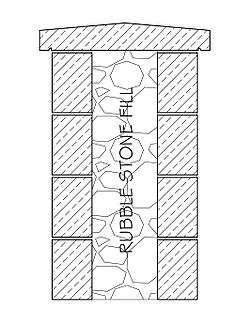Rubble masonry
Rubble masonry is rough, uneven building stone set in mortar, but not laid in regular courses.[1] It may appear as the outer surface of a wall or may fill the core of a wall which is faced with unit masonry such as brick or ashlar. Analogously, some medieval cathedral walls are outer shells of ashlar with an inner backfill of mortarless rubble and dirt.

History
The sack masonry is born as an evolution of embankment covered with boards, stones or bricks. The coating was used to give the embankment greater strength and make it more difficult for the enemies to climb. The Sadd el-Khafara dam, 14 meters high and built in sacking masonry in Wadi Al-Garawi near Helwan in Egypt, dates back to 2900 - 2600 BC [2]
The Greeks called the brickwork emplecton [3] [4] and made use of it in particular in the construction of the defensive walls of them poleis.
The Romans made extensive use of the sack masonry technique calling it opus caementicium, because caementicium was the name given to the filling cast between the two vestments. The masonry was used during the centuries up to our days, as evidenced by the medieval constructions of defensive walls and large works.
The "modern" brickwork is made with a concrete casting without any elements and with an internal steel reinforcement. This allows for greater elasticity, excellent static and seismic resistance and preserves the unity between shape and structure typical of buildings with external load-bearing walls. All the structural tasks can be assigned to the sack walls thus created, freeing the internal spaces from excessive constraints. [5]
See also
- Snecked masonry - Masonry made of mixed sizes of stone but in regular courses.
- Wattle and daub - Conceptually analogous to rubble within ashlar in the sense that a frame is filled in with a filler material.
Gallery
 The wall at Grave Circle A, Helladic cemetery of Mycenae, Greece, 16th century BCE
The wall at Grave Circle A, Helladic cemetery of Mycenae, Greece, 16th century BCE- Rubble masonry core of the unfinished Alai Minar in the Qutb complex, India, c. 1316 CE
References
- A Dictionary of Architecture, Fleming, Honour, & Pevsner
- Robert B. Jansen "Advanced dam engineering for design, construction, and rehabilitation" - Edited by RObert B. Jansen - Springer, 1988.
- RA Tomlinson Emplekton Masonry and 'Greek Structura' - The Journal of Hellenic Studies - Vol. 81, (1961), pp. 133-140
- Nic Fields & Brian Delf - Ancient Greek fortifications 500-300 BC - Osprey Publishing, 2006.
- A. Acocella, The architecture of brick facing, Rome 1989